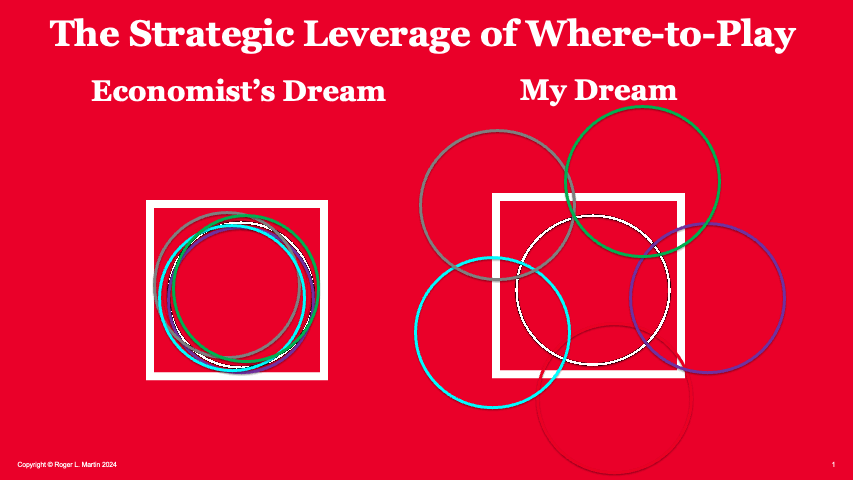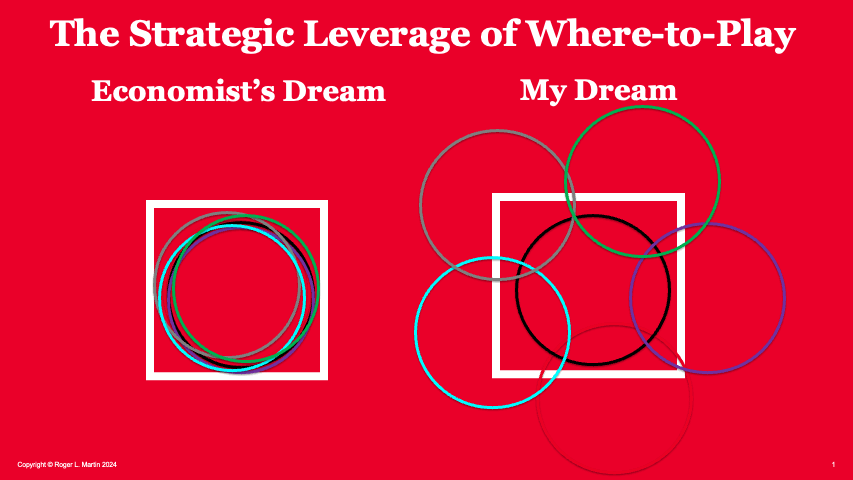Play to Win

I feel compelled to write about the importance of Where to Play (WTP). I continue to see extreme cases in thinking about this topic. On one hand, fundamentally, it is seen as about diversification - often unrelated. On the other extreme, it is viewed as predetermined and immutable. In my view, neither perspective is helpful. Therefore, I decided to provide an alternative view in this section on Play to Win/Knowledgeable Players (PTW/PI), the strategic leverage of Where to Play: allowing you to win.
Standard Perspectives
The first popular perspective on WTP - that it is all about diversification - is quite clear. The first reaction of executives when I mention WTP is that I am referring to diversification. That is, playing in a different place from its current WTP. There is almost always genuine excitement about that prospect because thoughts immediately go to more attractive places to play. That is, places with higher market growth rates, places with higher profit margins, places with higher value addition, or, in a perfect world, all three together!
The other perspective often held on WTP - that it is predetermined and immutable - is mostly implicit. I do not see executives explicitly stating this view, but it is clear in their actions. I have seen it in the newspaper industry (now defunct): Our business was gathering news, printing it on paper, selling through subscriptions and newsstands, and selling advertising. I have seen it in the automotive industry: to become a 'major OEM', we need to have a vehicle in every major box - for example: mid-size SUV, luxury SUV, full-size pickup, etc. Department stores: We need to have a full range of goods in every type that our competitors carry, and we must have stores in the same type of locations as competitors (i.e., types of streets and similar types of centers). I see it in banks: we need to be in personal, commercial, business, savings, checking, credit cards, mortgages, auto loans, mutual funds, etc. WTP is what it means in this industry. Anything else is unsuccessful, illegal, unfeasible, or some such prohibition/inhibition.
The Problem with the Diversification Definition
The perspective of WTP as diversification can be a useful perspective. I was a board member for nearly the entire transformation of Thomson (later Thomson Reuters) from a company in newspapers, textbooks, North Sea and European travel businesses into one of online information, must-have, subscription-based online information for professionals. It can be done, and I know from personal experience that it is very useful in that case to think about WTP expansively.
But most of the time, thinking about WTP as in a completely new space is a recipe for giving up failure, whether it is AT&T with Time Warner, Microsoft with Nokia, Google with Motorola Mobility, HP with Autonomy, News Corp with MySpace, Quaker Oats with Snapple, or even Daimler with Chrysler. Some combination of high growth, high margins, higher value addition is the siren call of those advocates (often strategic consultants and investment bankers) that cannot be resisted. Someone should take a shot at the executives diversifying into the mast!
The fundamental problem is that high growth means everyone and their cousins are trying to get into the market. Higher gross profits are there because the fixed costs of the business are much higher, and net margins and/or returns on capital are often not higher or are in fact lower. And more value? Frankly, the right question is: Who cares?
Another shortcoming of trying to improve your WTP by diversifying into a new WTP is that it does not address the inherent problems or challenges in the current WTP that lead you to explore a new WTP. The most common form of this is diversifying into another business to 'reduce the cyclicality of our current business', as often happens with commodity manufacturers. As I always point out to executives with this mindset, it does not reduce the cyclicality of your current business. It merely adds a new business to your portfolio - in which you are likely to fail - and leaves the existing cyclicality exactly as it is. Regardless of the absolute dollar costs of the cycle before diversification, they are exactly the same after diversification.
That said, I have given my cautionary advice on the topic of diversification in Chapter 14 of my latest book, a new way of thinking, so I will not continue on this part of the topic here. I will delve deeper into the more insidious issue - treating your WTP as predetermined and immutable.
The Problem with Treating Your WTP as Predetermined and Immutable
The other perspective - to treat your current WTP as ordained by a higher power - is like competing with one hand tied behind your back. While it may be exactly the same WTP as competitors and figuring out another HTW, it is really hard. It happens infrequently. The best way to build an attractive and valuable HTW is to have a unique WTP. It does not have to be completely non-overlapping with competitors, just uniquely along some dimensions.
A look at the top 100 market capitalization companies in the world reinforces this. You will find very few companies on the list with exactly the same WTP or even very similar to another company (or companies) on the list. To be sure, there are a few: the Troika of JPMC, Bofa, and Wells Fargo; and the duo of Visa and Mastercard. But that is just five out of one hundred.
One might cite Coca Cola and PepsiCo as another counterexample. But PepsiCo has nearly 30% of its revenue in Frito Lay, a completely non-overlapping WTP. Or one might argue that eleven (11) major pharmaceutical companies (Eli Lilly, Novo Nordisk, J & J, Merck, Abbvie, Roche, Novartis, Astrazeneca, Abbott, Amgen, and Pfizer) in the Top 100 have exactly the same WTP. But if you look at the 27 therapeutic areas they collectively list as focus areas, only five areas have four or more companies focused on the area. In 22 areas, there are three or fewer major players operating. And even in overlapping therapeutic areas, often defined, there are different subgroups. Do I think there is no overlap? Of course not. But no company has complete overlap with another company. Do I think there is some blood in some therapeutic areas, like cancer and cardiovascular? Yes, but not across the entire area. That is why there are eleven of them in the top 100.
It could be argued that 95% of the top 100 most valuable companies in the world have a unique WTP choice - which I would argue is critical for them on this list. Economists do not like that - at all. Economists prefer overlapping WTP, as illustrated in the left diagram above. It brings them closer to their Holy Grail, 'Perfect Competition', in which customers see competitors as interchangeable and, because of that, can force competitors to compete prices down to unsustainable profit levels. Economic love, love, love that - but surely it is not a formula for engaging in the top 100 market value companies.
A major problem is that while you are busy overlapping with competitors' WTP, someone will figure out a smarter WTP. eBay says: Let’s not do all that nonsense, let’s compete in classified ads. Ford says: cars are unnecessary as the world shifts to favor the SUV form factor. Price Club (later merged with Costco to become the giant we know today) says: Let the department stores and mass merchants carry every item that shoppers might want while we will only carry the others (it only carried items that turned over once a month and marked them up 10% while competitors turned over on average once a quarter and marked them up 40% - so customers shopped for fast-turn items at Price Club/Costo and all slow-moving items at Competition, a top strategy of the great beggar as average store inventory turned over competition has plummeted.) Capital One says: How about we just do credit cards (and have been hugely successful, although later moved to competitors by expanding its WTP to WTP like a bank, a change I do not favor).
Mandate WTP
The mandate of WTP is spreading - illustrated above right. Any amount of spreading is good. Go as far away from overlapping as possible with your WTP - like eBay, Ford, Costco, and Capital One. Logic chips, not memory chips for Intel. Graphics chips not regular logic chips for Nvidia. Small towns for Walmart - until they are big enough to go into cities and destroy Sears and Kmart. Smartphones and smartphone components for Samsung. Frito Lay for PepsiCo. Prepaid subscriptions for T-Mobile. The entire range of luxury goods for LVMH. Just index funds for Vanguard.
The gift you receive when you achieve uniqueness in your WTP is that it opens up different types of HTW compared to the industry standard. Vanguard can become a low-cost player by having no costs associated with investment managers. Walmart grows by scale in small towns and then uses its model to enter larger cities and destroy incumbents. Samsung has achieved a low-cost position in the Android-based smartphone business by selling smartphone components to everyone else in the business to achieve large-scale advantages. Intel and Nvidia focus on differentiating in what they do best and uniquely.
Success stories do not primarily diversify in the classical sense - although in the case of PepsiCo and Frito Lay (i.e., diversifying beyond beverages). Most involve choosing a more specific WTP largely within the confines of existing industry rules for WTP. But by choosing a specific WTP, the company in question can create an HTW that only works for that WTP.
A very favorable outcome is that the WTP/HTW combination does not drive immediate fit. Competitors are perfectly satisfied with their existing WTP and often stick with it, often not noticing the new WTP/HTW combination until it is too late - as is the case with Walmart, Vanguard, Costco, T-Mobile, and many others. This phenomenon often occurs in the case of newcomers like Amazon and Tesla, who choose WTP that incumbents consider not very promising - until it is too late.
Knowledgeable Practitioners
Always think of WTP as flexible and nuanced. Small changes in WTP can open up large possibilities for HTW. If you are struggling with HTW - as companies often do - don’t pull your hair out trying to find HTW in your current WTP. There may not be one. Instead, start playing with your WTP - and I mean play. Be playful as you explore possibilities. Narrow it down from the industry standard - like Vanguard, Walmart, Costco, Intel, and Nvidia. And expand it - like Samsung, PepsiCo, and LVMH. Don’t imagine that you have to make a huge change in WTP. Any spreading will help you open up unique WTP possibilities.
It is scary because it is a choice. It is making a real strategic choice - because the opposite is not stupid; the opposite is the WTP that others have chosen. That is why most executives are anxious about doing it - and the vast majority simply do not. That is why there is so much overlap out there in the WTP of companies operating modestly.
But it is important to remember that if you cannot find HTW in your current WTP, you will expire. Maybe it won’t be today or tomorrow or this year - but eventually.
So, start playing with your WTP. Come up with three to five different WTP modifications that you can find a pair of HTW. Then think them through and choose one that the most compelling case can be made!
